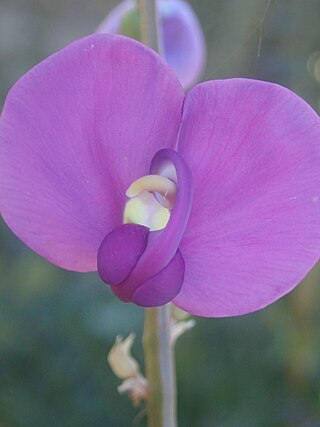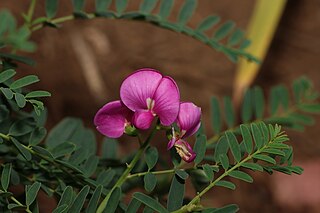
Swainsona procumbens, commonly known as Broughton pea or swamp pea is a species of flowering plant in the pea family (Fabaceae), and is native to Australia. It is a spreading or ascending perennial shrub-like herb with imparipinnate leaves with 15 to 25 linear to narrowly lance-shaped leaflets with the narrower end towards the base, and racemes of 2 to 12 purple or mauve to pink flowers.

Swainsona stenodonta is a species of flowering plant in the family Fabaceae and is endemic to the north-west of Western Australia. It is an erect annual herb, with imparipinnate leaves with 7 to 13 narrowly linear or oblong leaflets, and racemes of up to 30 or more dark brownish-red to dark purple flowers.

Swainsona campylantha, commonly known as Gilgai Darling pea, is a species of flowering plant in the family Fabaceae and is endemic to inland areas of Australia. It is a low-growing perennial with imparipinnate leaves usually with up to 7 narrowly lance-shaped to narrowly elliptic leaflets, and racemes of 2 to 10 pink to purple flowers.
Swainsona eremaea is a species of flowering plant in the family Fabaceae and is endemic to South Australia. It is a low-growing, spreading, probably perennial plant with imparipinnate leaves with 5 to 11 linear, oblong to broadly wedge-shaped leaflets, and racemes of bright red to brown or yellow flowers in racemes of 5 to 20.
Swainsona fuscoviridis is a species of flowering plant in the family Fabaceae and is endemic to South Australia. It is a perennial plant with many stems and imparipinnate leaves with mostly 7 or 9 ellipitic, linear or egg-shaped or lance-shaped leaflets, and racemes of 12 to 20 purple flowers.
Swainsona gracilis is a species of flowering plant in the family Fabaceae and is endemic to the south-west of Western Australia. It is a prostrate or ascending perennial herb with imparipinnate leaves with up to 15 wedge-shaped or narrowly oblong leaflets, and racemes of up to 4 purple or blue flowers.
Swainsona halophila is a species of flowering plant in the family Fabaceae and is endemic to inland areas of Western Australia. It is usually a prostrate annual herb with imparipinnate leaves with 9 to 13 egg-shaped to broadly wedge-shaped leaflets, and racemes of 2 to 9 purple flowers.
Swainsona incei is a species of flowering plant in the family Fabaceae and is endemic to inland Western Australia. It is an erect or ascending annual, sometimes perennial herb with imparipinnate leaves with 5 to 9 lance-shaped to elliptic leaflets, and racemes of 2 to 30 purple flowers.
Swainsona kingii is a species of flowering plant in the family Fabaceae and is native to Western Australia and South Australia. It is a prostrate or ascending annual or perennial herb, with imparipinnate leaves with usually 5 egg-shaped leaflets with the narrower end towards the base, and racemes of 1 to 3 pink to purple flowers.
Swainsona microcalyx, commonly known as wild violet, is a species of flowering plant in the family Fabaceae and is endemic to southern mainland Australia. It is a prostrate or low-growing perennial herb, with imparipinnate leaves with 5 to 9 broadly egg-shaped to wedge-shaped leaflets and racemes of 5 to 15 purple flowers.
Swainsona oliveri is a species of flowering plant in the family Fabaceae and is endemic to south-western Australia. It is a slender, prostrate to ascending annual or perennial herb with imparipinnate leaves with 9 to 13 narrowly egg-shaped leaflets, the narrower end towards the base, and racemes of up to 4 cream-coloured to yellow flowers, sometimes with a pink tinge.
Swainsona parviflora is a species of flowering plant in the family Fabaceae and is endemic to the eastern Australia. It is a low-lying perennial with imparipinnate leaves with 5 to 11 narrowly elliptic to narrowly lance-shaped or oblong leaflets, and racemes of 3 to 10 purple flowers.
Swainsona pedunculata is a species of flowering plant in the family Fabaceae and is endemic to inland areas of Western Australia. It is a small, ascending annual herb with imparipinnate leaves with 3 to 7 narrowly elliptic or lance-shaped leaflets, and racemes of 2 to 3 purple flowers.
Swainsona perlonga is a species of flowering plant in the family Fabaceae and is endemic to inland parts of the south-west of Western Australia. It is a scrambling perennial herb with imparipinnate leaves with 7 to 13 egg-shaped or almost round leaflets, and racemes of 7 to 10 purple to lilac-pink flowers.

Swainsona purpurea, commonly known as purple Swainson-pea or purple Darling pea, is a species of flowering plant in the family Fabaceae and is endemic to arid areas of inland Australia. It is an erect or spreading annual or perennial plant with imparipinnate leaves with 3 to 11 mostly linear or elliptic leaflets, and racemes of 3 to about 20 purple flowers.

Swainsona queenslandica, commonly known as smooth Darling pea, is a species of flowering plant in the family Fabaceae and is endemic to eastern Australia. It is a perennial herb with imparipinnate leaves with 19 to 25 egg-shaped leaflets with the narrower end toward the base, and racemes of about 20 white, pinkish to orange red or dark red flowers.
Swainsona rotunda is a species of flowering plant in the family Fabaceae and is endemic to inland areas of northern Western Australia. It is a prostrate herb with imparipinnate leaves with about 7 narrowly lance-shaped leaflets, and racemes of up to 4 lilac-coloured flowers.
Swainsona tanamiensis is a species of flowering plant in the family Fabaceae and is endemic to north-western Australia. It is a prostrate or erect perennial plant with imparipinnate leaves with 5 to 13 broadly egg-shaped to elliptic, or almost round leaflets, and racemes of up to 8 purple flowers.

Swainsona tephrotricha is a species of flowering plant in the family Fabaceae and is endemic to eastern South Australia. It is an erect or ascending perennial plant, with imparipinnate leaves with 7 to 19 broadly egg-shaped to narrowly elliptic leaflets, and racemes of 30 or more pink or pinkish-purple flowers.
Swainsona vestita is a species of flowering plant in the family Fabaceae and is endemic to central-northern South Australia. It is an erect or ascending perennial plant with imparipinnate leaves with about 7 narrowly lance-shaped leaflets, and racemes of 5 to 20 purple flowers.






